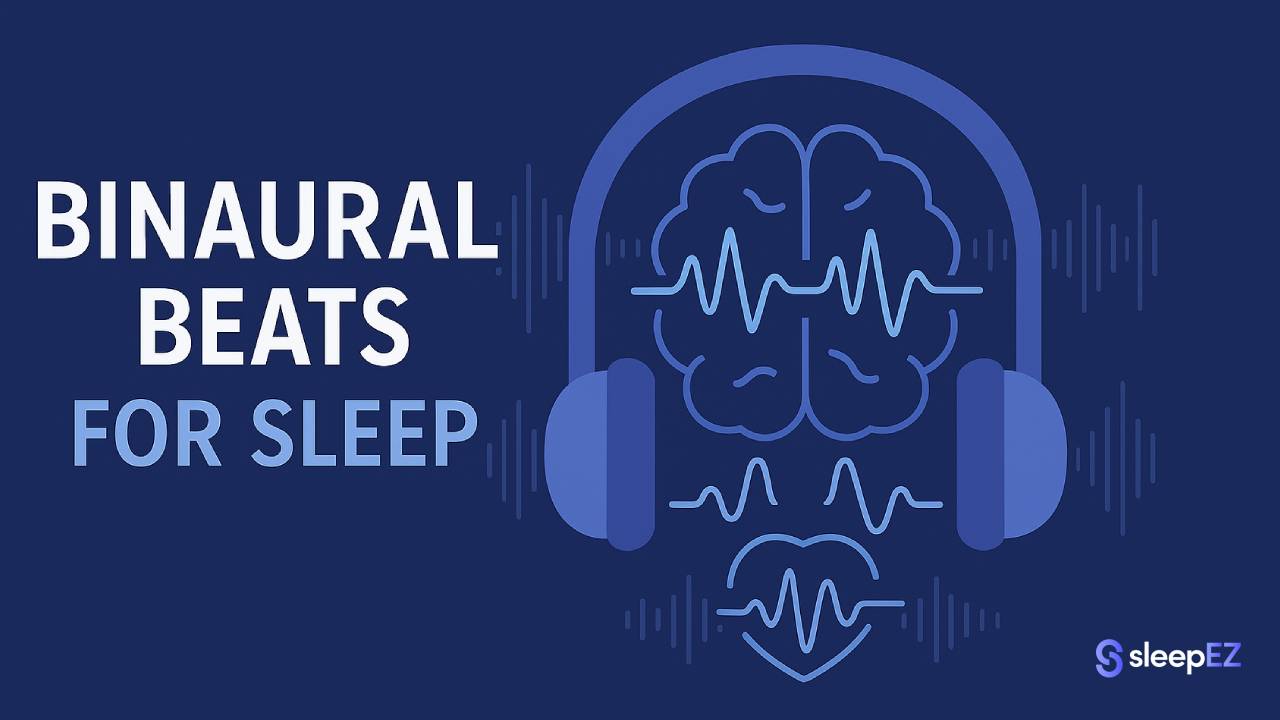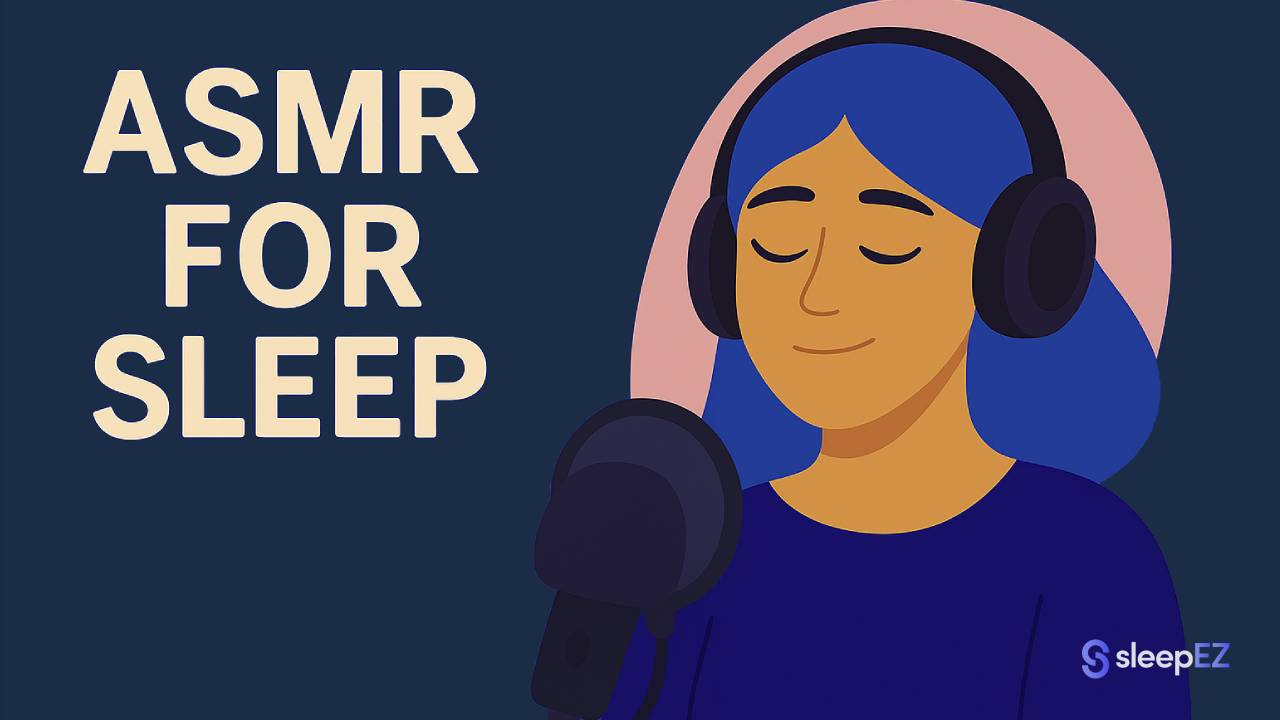Binaural beats might help you fall asleep faster and sleep deeper. These audio frequencies claim to sync your brainwaves with relaxing rhythms. But do they actually work, and are they safe?
This guide explains what binaural beats are, how they affect your brain, and whether science backs their sleep benefits. You'll also learn how to use them safely for better rest.
What Are Binaural Beats?
Binaural beats are rhythmic pulses you hear when two different sound frequencies play in each ear at the same time. Your brain creates these beats by calculating the difference between the two frequencies.
Here's a simple example: If you hear 300 Hz in your left ear and 310 Hz in your right ear, your brain creates a 10 Hz binaural beat (310 - 300 = 10). This beat doesn't actually exist in the audio—it's created entirely by your brain.
The process works through something called brainwave entrainment. Your brain tries to sync its electrical activity to match the rhythm of the binaural beat you're hearing. This synchronization may influence your mental state, potentially promoting relaxation, focus, or sleep depending on the frequency used.
You need stereo headphones or earphones to experience binaural beats. The frequencies must be separate for each ear. Regular speakers won't work because both ears hear both frequencies.
A Bluetooth sleep mask like the Dreamy Sounds Sleep Mask is ideal for this. You can stream binaural beats wirelessly from any app on your phone while blocking out light completely.
How Do Binaural Beats Work?
Binaural beats work through a process called brainwave entrainment. This means your brain starts to match its electrical activity to the rhythm of the beats.
Your brain naturally produces electrical waves at different frequencies throughout the day. These brainwaves change based on what you're doing and how you feel.
When you listen to binaural beats, the theory suggests your brain gradually shifts to match the frequency of the beat. If you listen to a 4 Hz binaural beat, your brain might start producing more 4 Hz delta waves, which are linked to deep sleep.
This synchronization doesn't happen instantly. It usually takes 15-30 minutes of consistent listening for your brainwaves to start matching the beat frequency.
Read: Best Bluetooth Sleep Mask in Australia
Brainwave Frequencies & Their Effects
Different brainwave frequencies are linked to different mental states. Here's what each range typically does:
Gamma Waves (30-100 Hz) Your brain at full speed. These fast waves happen during intense focus and problem-solving. Way too energizing for bedtime.
Beta Waves (14-30 Hz) Regular daytime thinking. You're in beta when working, talking, or making decisions. Higher beta can make you anxious and wired.
Alpha Waves (8-14 Hz) The calm-but-awake zone. Think of sitting quietly or daydreaming. Alpha waves bridge the gap between being alert and sleepy, making them useful for evening relaxation.
Theta Waves (4-8 Hz) Deep chill mode. Your brain produces theta during meditation, light sleep, and vivid dreams. Many sleep-focused binaural beats target this range.
Delta Waves (0.5-4 Hz) The deepest sleep state. Delta waves dominate during dreamless sleep when your body repairs itself. These slow frequencies are your best bet for sleep binaural beats.
Most sleep-focused binaural beats use theta (4-8 Hz) or delta (0.5-4 Hz) frequencies to promote relaxation and sleep.
Do Binaural Beats Help You Sleep?
The research on binaural beats for sleep shows mixed but promising results. Some studies suggest benefits, while others show little effect.
A 2018 study found that people who listened to binaural beats for 30 minutes before bed fell asleep faster and reported better sleep quality. The participants used 6 Hz beats (theta frequency) for six weeks.
Another study with athletes showed that 2 Hz and 8 Hz binaural beats improved both sleep quality and athletic performance. The athletes listened to the beats for 25 minutes before bedtime.
However, not all research shows positive results. Some studies found no significant difference between binaural beats and regular relaxing music for sleep improvement.
The effectiveness might depend on several factors:
- Individual brain chemistry
- Consistency of use
- Volume and duration
- Background noise levels
- Personal belief in the treatment
While binaural beats aren't a magic cure for insomnia, they may help some people relax and fall asleep more easily.
Latest Research
Recent research explores more advanced binaural beat techniques. Dynamic binaural beats change frequency throughout the session, potentially following natural sleep cycles.
A 2019 systematic review looked at multiple binaural beat studies. The researchers found modest evidence for improved relaxation and reduced anxiety, but called for more rigorous studies on sleep benefits.
Some newer research focuses on personalizing binaural beat frequencies based on individual EEG patterns. This approach might be more effective than using the same frequencies for everyone.
Scientists are also studying how binaural beats interact with other sleep aids like melatonin and meditation techniques.
How to Use Binaural Beats Safely
Using binaural beats safely requires the right equipment and proper listening habits.
Choose Quality Headphones You need stereo headphones or earphones that deliver clear, separate audio to each ear. A Bluetooth sleep mask offers the perfect solution for bedtime binaural beats. The Dreamy Sounds Sleep Mask delivers precise stereo separation through ultra-thin 4mm speakers that won't cause pressure, even when sleeping on your side.
The Bluetooth connection lets you stream binaural beats from YouTube, Spotify, or specialized apps without wires getting tangled during sleep. The 15+ hour battery means you can use it for multiple nights without charging.
Set Safe Volume Levels Keep the volume at comfortable listening levels. You should hear the beats clearly without strain. Loud volumes can damage your hearing and make it harder to fall asleep.
Start with Short Sessions Begin with 15-30 minute sessions before extending to longer periods. Some people listen for entire sleep cycles, but start short to see how you respond.
Choose the Right Frequency For sleep, stick to theta (4-8 Hz) or delta (0.5-4 Hz) frequencies. Higher frequencies can be too stimulating for bedtime.
Time Your Sessions Listen to binaural beats 30-60 minutes before your intended sleep time. This gives your brain time to sync with the frequencies and start relaxing.
With a Bluetooth sleep mask, you can set an auto power-off timer for 1 or 2 hours. This saves battery and creates silence once you've fallen asleep, preventing the audio from disrupting your sleep cycles.
Create a Consistent Routine Use binaural beats at the same time each night as part of your bedtime routine. Consistency helps your brain learn the association between the beats and sleep time.
Combine with Good Sleep Hygiene Binaural beats work best alongside proper sleep habits like keeping a cool room, avoiding screens before bed, and maintaining regular sleep schedules.
Side Effects & Who Should Be Cautious
Most people can use binaural beats safely, but some should be careful or avoid them entirely.
Potential Side Effects:
- Headaches from volume too high or sessions too long
- Dizziness or nausea in sensitive individuals
- Irritability if used at wrong frequencies
- Hearing damage from excessive volume
Who Should Avoid Binaural Beats People with epilepsy or seizure disorders should not use binaural beats. The rhythmic audio patterns could potentially trigger seizures in susceptible individuals.
Those with pacemakers should consult their doctor before using binaural beats, as there's limited research on potential interactions.
Children under 12 should only use binaural beats under adult supervision, as their developing brains might respond differently to audio entrainment.
When to Stop Using Them Stop using binaural beats if you experience persistent headaches, increased anxiety, or sleep disruption. Some people find certain frequencies too stimulating rather than relaxing.
If you notice hearing changes or ear discomfort, reduce volume or take a break from binaural beats.
Conclusion
Binaural beats may help you fall asleep faster and sleep better. They work best with quality headphones, safe volume levels, and theta or delta frequencies. A Bluetooth sleep mask like the Dreamy Sounds Sleep Mask is perfect for this, combining comfortable audio delivery with complete light blocking.
Start with short 15-30 minute sessions and be patient. Results may take weeks of regular use. Binaural beats work best alongside good sleep habits, not as a cure-all. For serious sleep issues, see a healthcare provider.



Leave a comment
This site is protected by hCaptcha and the hCaptcha Privacy Policy and Terms of Service apply.